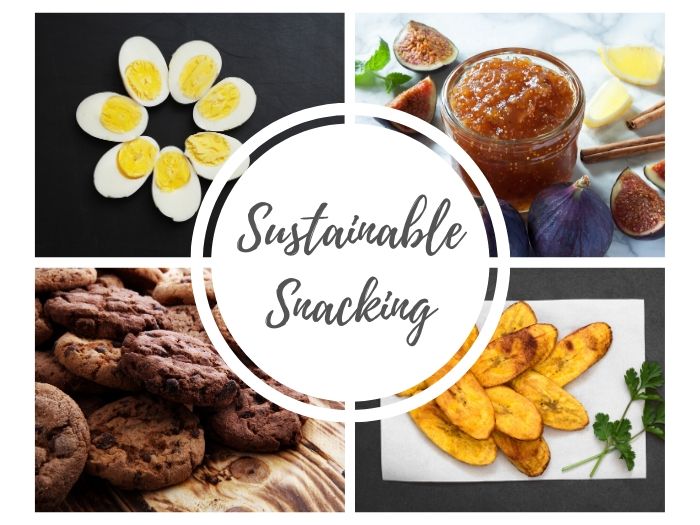No matter how great it tastes, snacking is bad for you in more ways than one. Not only are most snacks unhealthy, but they also harm the planet. From sourcing, processing, packaging to transportation, most readily available snacks have a damaging effect on the environment. Yet, it is almost impossible not to snack. The three-meals-a-day diet leaves one hungry and often sapped of energy. Sustainable snacking bridges the gap between satisfying hunger and living a healthy sustainable life. It is a more responsible way of sourcing and eating which also benefits your own well-being.
What is Sustainable Snacking?
Sustainable snacking is part of the new trend in sustainable food. It is decided by how the product is sourced, packaged, processed, and reaches you. Unlike the readily available, fried, and heavily processed options, these snacks are actually good for you. More importantly, they are produced in a humane manner that is ecologically viable, economically fair, and socially responsible. It is healthy and produced in a manner that does not hurt the planet.

How to Identify a Sustainable Snack?
Sustainable snacks do seem to cover a lot of ground. While there are many brands that may claim the tag, not all actually follow the principles of sustainability. So, you need to see beyond the label when deciding whether a snack is sustainable or not. There are many companies that offer a gamut of sustainable snacks in the US today. Some of the essential attributes of such snacks are:
- Local: The most sustainable snacks are sourced locally. As per the Farm Bill of 2008, any food that is grown and transported within 400 miles or in the same state is defined as local food. A comprehensive review of local food published by NC State University found that it benefited the economy, environment, and individual health. Local food is fresh, encourages the local economy and reduces transportation costs. [1]
- Non-GMO: Sustainable food aims to encourage local produce. The aim of the non-GMO label is to ensure that the consumer understands the product is not genetically modified. However, this is a call you can make on an individual level. Non-GMO snacks will often carry this label.
- Organic: Any sustainable snack must be organic. Organic farming means that chemical pesticides and fertilizers were not used in the food production process. When looking for snacks, organic food refers to the sourcing of the ingredients. Since organic food is high in demand and priced higher, the packaging will clearly state organic sourcing.
- Processing: As a healthy alternative, sustainable snacks are the least processed. Look for ingredients that are not highly processed and are closer to the whole food version. For instance, oils and fats like olive oil and not refined oil or whole grains instead of refined flours. Processing also refers to the way the company runs its operations. For instance, Clif Bar, a California-based organic foods company, runs a 90 percent waste-free operation with carbon-neutral status. The company also keeps a strict tab on its suppliers and offers complete traceability of its ingredients.
- Healthy: Potatoes fried in lard or a cheesy burger does not become sustainable even if the potatoes were sourced locally and the burger is made of whole grain. Healthy food is the number one priority. To make the same meal sustainable, look for healthier food processing, such as baked chips or a locally sourced meat.
- Packaging: One of the most essential requirements of sustainable snacks is environmental-conscious packaging. Food packaging has been a major environmental concern as it is a major cause of soil and water pollution. Plastic food packets are now damaging the coral reefs. As a result, the focus has now shifted to sustainable packing. Many brands are now going for innovative solutions that are constantly pushing the boundaries. Innovative solutions include compostable wrappers by Alter Eco Truffles or reusable bags by ChicoBag’s snacks. [2]
- Sourcing: An important aspect of sustainable snacks is the sourcing of the ingredients. This is a trickier subject because it requires you to understand how sourcing can hurt or benefit a community or the environment. A sustainable ingredient does not harm the environment during its harvesting/growth, ensures fair wages, and working conditions for people involved in its harvesting. Many companies have taken this further by taking on sustainable practices. For example, Washu chocolate helps protect cocoa farmers and monkeys in Ecuador. GoMacro Bars are working actively for reforestation. Barnana focused on food waste, upcycling bananas that were deemed too ‘ugly’ by supermarkets to offer a range of banana-based snacks like chips and peanut butter cups.
Options for Sustainable Snacking
If you are looking for sustainable snacking in the US, there are plenty of options to choose from. The best option would be to shop locally and make them yourself. However, not everyone has the skill, the inclination or the desire to make their snack from scratch. So, here are a few other options you can look at:
Cookies: If you love your baked goods, sustainable cookies and biscuits are available widely. Emmi’s Organic Dark Cacao Coconut Cookies are made with wholesome ingredients and good for a paleo diet. Nature’s Path Sunrise Breakfast is made with blueberries and chia. Rythm 108 offers tea biscuits with flavors like chocolate hazelnut and lemon & ginger.
Chocolates: There is nothing like chocolate when you want an instant hit of energy and feel-good mood. It also seems to be the favorite option in sustainable snacking brands. Options include Innocent Chocolate, Zimt’s organic Treats, Doisy & Dam, Heavenly Organics, Daily Dose of Dark and many such brands.
Energy bars: Today energy bars come in all styles. Chapul Cricket Bars are made with cricket flour and available in dark chocolate and matcha varieties. Lovechock has a line of granola bars that are raw vegan-friendly. If you want simple cereals, you can opt for Mazra Dry Cereal.
Crisps: Instead of going for greasy fries, oven-roasted crisps have emerged as a more sustainable choice. Whole Food has a wide range of choices here, from pea crisps to ranch lentil crisps, and coconut chips.
Fresh food options: The most sustainable option is, of course, fresh food. Eating fresh fruits for snacks is always a healthy choice. You can also keep pre-cut carrots, celery, and apples with a little dip for quick snacking. You can also buy pre-cut vegetables or boiled eggs for quick access.
With so many options available, living a sustainable life has become easier. Whether you make them yourself or buy them from a grocery store, sustainable snacks can help you live a healthy, clean, and environment-friendly life.
